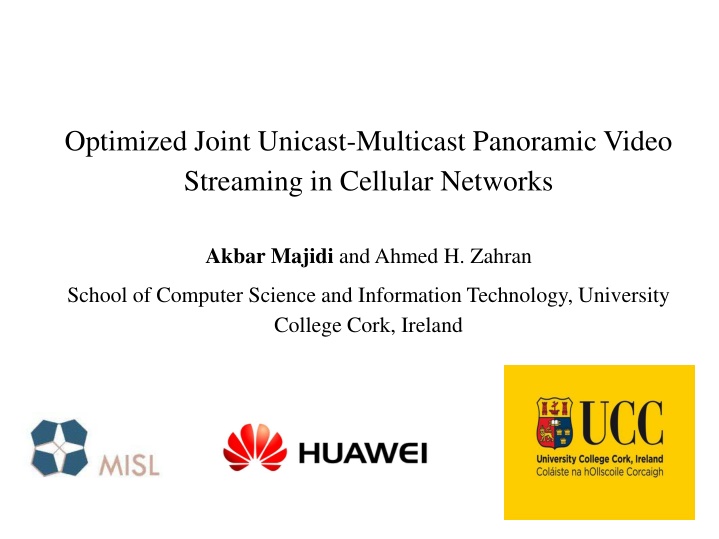
Optimized Panoramic Video Streaming in Cellular Networks
Enhance your understanding of joint unicast-multicast panoramic video streaming in cellular networks with a focus on ultra-HD resolutions and maximizing user experience through innovative optimization techniques. Dive into the world of VR and AR technologies fueling the popularity of panoramic media with a look at the motivation behind using joint unicast and multicast for diverse Field of Views. Explore the standardization of multimedia broadcast multicast services and the JUMPS operation solution offering multicasted and unicasted tiles for optimal user experience.
Download Presentation

Please find below an Image/Link to download the presentation.
The content on the website is provided AS IS for your information and personal use only. It may not be sold, licensed, or shared on other websites without obtaining consent from the author. If you encounter any issues during the download, it is possible that the publisher has removed the file from their server.
You are allowed to download the files provided on this website for personal or commercial use, subject to the condition that they are used lawfully. All files are the property of their respective owners.
The content on the website is provided AS IS for your information and personal use only. It may not be sold, licensed, or shared on other websites without obtaining consent from the author.
E N D
Presentation Transcript
Optimized Joint Unicast-Multicast Panoramic Video Streaming in Cellular Networks Akbar Majidi and Ahmed H. Zahran School of Computer Science and Information Technology, University College Cork, Ireland
Panoramic video I believe in innovation and that the way you get innovation is you fund research and you learn the basic facts. Bill Gates The advance in Virtual reality (VR) and Augmented reality (AR) technologies fuels the popularity of panoramic media. 2
Problem Statement Requires using Ultra-HD resolutions, e.g., 4K and above. High data-rate requirements than traditional videos. 3
Motivation Tiles are encoded independently FoV is different across users Diversity in FoV motivates to use joint unicast and multicast. Multicasting all tiles could lead to inefficient use of resources. 4
Multimedia Broadcast Multicast Service Standardize the architecture. The content is delivered over one or more base stations (BS) . A Multicast Coordination Entity (MCE). 5
JUMPS Optimization Objective => maximizing the total user experience Const 1=>ensure resources are limited to the available resources. Const 2 => ensure every user receives every tile only once The objective and constraints are linear in the problem binary variables. Thus, it can be solved using integer programming solvers. 6
JUMPS Operation Solution offers: Multicasted tiles and their corresponding quality Unicasted tile for every user and corresponding quality Result: Number of RBs would be smaller than the total number of allocated RBs. It is expected to reduce user battery consumption as users listen to fewer RBs. 7
Simulation Setup Performance evaluation is based on a custom-built using Python. We compare JUMPS with the resource assignment algorithm of VRCast. We solve our optimization problem with Gurobi 9.0 Solver. Our reported results represent the outcome of 50 runs. 1) Eltobgy, Omar, Omar Arafa, and Mohamed Hefeeda. "Mobile Streaming of Live 360-Degree Videos." IEEE Transactions on Multimedia (2020). 8
Performance Evaluation Scenarios We present the results for the following scenarios: Users with Diversified FoV, Weak Link Condition, and Limited resource network (DWL) Users with Diversified FoV, Good Link Condition, and Limited resource network (DGL) Users with Diversified FoV, Weak Link Condition, and Abundant resource network (DWA) Users with Focused FoV, Good Link Condition, and Limited resource network (FGL) 9
Conclusion A new resource management scheme for delivering popular panoramic content to user groups in cellular systems. JUMPS exploits both unicast and multicast to improve system. Our evaluation shows that JUMPS always significantly improves the performance For larger groups, JUMPS maintains high-performance. As future work, we consider generalizing JUMPS to manage cellular resources for multiple user groups and multiple base stations (SFN case). 15
Thank you ! 16
